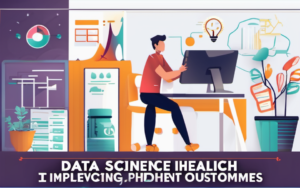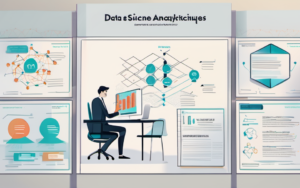The impact of Data Science is undeniable, reshaping industries and influencing our daily lives in ways unimaginable just a few decades ago. Its evolution, especially since the dot-com era, is a fascinating journey of technological leaps and shifting paradigms. Let’s explore this transformation.
1. The Dot-Com Bubble and its Legacy on Data Science
The dot-com bubble, with its rapid expansion and subsequent burst, significantly shaped the early landscape of Data Science. While the era saw the initial seeds of data-driven decision-making planted, the tools and techniques were rudimentary compared to today’s standards.
The sheer volume of data generated by burgeoning e-commerce platforms, however, presented both a challenge and an opportunity. Businesses suddenly found themselves awash in customer information—purchase history, browsing patterns, and demographic data—but lacked the sophisticated analytical capabilities to fully leverage it. This underscored the growing need for better data science tools and methodologies.
1.1 Early Data Science: Limited Tools and Datasets
Early data scientists often relied on limited computational resources and relatively small datasets. Statistical software packages like SAS and SPSS were prevalent, but their capabilities were constrained by the technology of the time. Data storage and processing power were significantly less advanced than what we have today, limiting the complexity of analysis. The impact of the dot-com bust on data science was a period of consolidation and refinement, focusing on more efficient and practical applications. Data visualization was also far less advanced, hindering the ability to communicate insights effectively.
1.2 The Rise of E-commerce and Data Collection
Despite the limitations, the dot-com era witnessed a surge in data collection. E-commerce giants like Amazon and eBay generated massive amounts of transactional data, creating a foundation for future advancements in Data Science. This period laid the groundwork for the development of more sophisticated data mining techniques and algorithms to extract meaningful insights from the burgeoning datasets. The sheer volume of data being collected, although initially overwhelming, became the fuel for the Data Science revolution to come. This unexpectedly large quantity of data forced early data scientists to develop more efficient methods to process and analyze it.
1.3 Challenges and Limitations of Early Data Analysis
The early stages of Data Science were hampered by several challenges. The lack of standardized data formats and the absence of powerful computing infrastructure made data analysis a laborious and time-consuming process. Furthermore, the relatively nascent field lacked the theoretical frameworks and established best practices that now guide modern Data Science. Many early analyses were limited in scope and lacked the statistical rigor of today’s sophisticated models. The comparison of data science then and now reveals a stark contrast in scale, sophistication, and accessibility.
2. The Rise of Big Data and Advanced Analytics
The post-dot-com era witnessed an explosion of data, driven by the proliferation of the internet, mobile devices, and social media. This “Big Data” revolution, characterized by massive volumes, velocity, and variety of data, necessitated new approaches to data storage, processing, and analysis.
The development of cloud computing provided the necessary infrastructure to handle the ever-increasing volume of data. Distributed computing systems like Hadoop and Spark emerged, enabling parallel processing of massive datasets. This allowed data scientists to tackle complex analytical tasks that were previously intractable.
2.1 The Explosion of Data Volume and Variety
The sheer volume and variety of data became a defining characteristic of the post-dot-com era. Data now came from diverse sources—social media, sensor networks, transactional databases—presenting both opportunities and challenges for Data Science. The rise of unstructured data (text, images, videos) required the development of new techniques for data processing and analysis, moving beyond traditional structured databases. This period saw the rise of NoSQL databases to accommodate the ever-growing need for flexible data storage and management solutions.
2.2 The Development of Cloud Computing and Distributed Systems
Cloud computing played a pivotal role in enabling the analysis of Big Data. Cloud platforms like Amazon Web Services (AWS), Google Cloud Platform (GCP), and Microsoft Azure provided scalable and cost-effective solutions for data storage and processing. Distributed computing frameworks like Hadoop and Spark emerged, enabling the parallel processing of massive datasets across clusters of computers, significantly reducing processing times. This allowed for far more complex and comprehensive data analyses than were previously possible.
2.3 Advancements in Machine Learning Algorithms
The rise of Big Data was accompanied by significant advancements in machine learning algorithms. Deep learning, a subfield of machine learning, gained prominence, enabling the development of highly accurate predictive models for a wide range of applications. The availability of large datasets and increased computational power fueled the development and refinement of these algorithms, leading to breakthroughs in areas such as image recognition, natural language processing, and speech recognition.
3. Key Technological Advancements
Several key technological advancements propelled the evolution of Data Science. These advancements not only enabled the analysis of larger and more complex datasets but also made Data Science more accessible to a wider range of users.
3.1 The Evolution of Programming Languages (Python, R)
Programming languages like Python and R became the dominant tools for Data Science. Python’s versatility and extensive libraries (like Pandas, NumPy, and Scikit-learn) made it particularly well-suited for a wide range of data-related tasks. R, with its strong statistical capabilities, remained a popular choice for statistical modeling and data visualization. The rise of open-source software significantly contributed to the accessibility and growth of Data Science.
3.2 The Development of Powerful Data Visualization Tools
Data visualization tools have evolved dramatically, enabling the effective communication of complex data insights. Tools like Tableau and Power BI offer interactive dashboards and visualizations, making it easier to communicate findings to both technical and non-technical audiences. These tools are essential for turning raw data into actionable insights, facilitating informed decision-making across various industries.
3.3 The Growth of Open-Source Software and Libraries
The growth of open-source software and libraries has played a crucial role in making Data Science more accessible and collaborative. The availability of free and readily available tools and resources has lowered the barrier to entry for aspiring data scientists, fostering innovation and collaboration within the community. This open-source nature accelerates progress and ensures wider adoption of new techniques and methodologies.
4. Impact Across Industries
The transformative impact of Data Science is evident across a range of industries. From optimizing marketing campaigns to revolutionizing healthcare, Data Science is driving innovation and efficiency.
4.1 Revolutionizing Marketing and Customer Relationship Management
Data Science has fundamentally reshaped marketing and customer relationship management (CRM). Targeted advertising, personalized recommendations, and predictive customer churn modeling are just a few examples of how Data Science is optimizing marketing strategies and enhancing customer experiences. The ability to analyze vast amounts of customer data allows businesses to tailor their offerings and communications for maximum impact.
4.2 Transforming Healthcare with Predictive Analytics and Personalized Medicine
In healthcare, Data Science is enabling breakthroughs in personalized medicine, predictive analytics, and disease diagnosis. By analyzing patient data, Data Science can identify individuals at high risk of developing certain diseases, allowing for early intervention and preventative measures. Predictive analytics is also used to optimize hospital resource allocation and improve patient outcomes.
4.3 Reshaping Finance with Algorithmic Trading and Fraud Detection
The finance industry has leveraged Data Science for algorithmic trading, fraud detection, and risk management. Algorithmic trading systems use sophisticated algorithms to execute trades at optimal prices, while fraud detection systems analyze transactions to identify suspicious patterns and prevent financial crimes. Data Science helps mitigate risks and optimize investment strategies.
4.4 Optimizing Supply Chains and Logistics with Data-Driven Insights
Data Science is revolutionizing supply chain management and logistics by optimizing inventory levels, predicting demand, and improving delivery efficiency. By analyzing real-time data on inventory, transportation, and customer demand, companies can streamline their operations, reduce costs, and enhance customer satisfaction. This optimization leads to improved efficiency and reduced waste across the entire supply chain.
5. The Future of Data Science
The field of Data Science is constantly evolving, with new technologies and techniques emerging at a rapid pace.
5.1 The Growing Importance of Data Ethics and Privacy
As Data Science becomes increasingly integrated into various aspects of our lives, the ethical implications of data collection and use are becoming increasingly important. Data privacy concerns, algorithmic bias, and the responsible use of artificial intelligence are critical considerations for the future of Data Science. Ensuring fairness, transparency, and accountability in the development and deployment of data-driven systems is paramount.
5.2 The Rise of Artificial Intelligence and its Integration with Data Science
Artificial intelligence (AI) is closely intertwined with Data Science, with AI algorithms often relying heavily on data analysis. The integration of AI and Data Science is leading to the development of increasingly sophisticated and autonomous systems. This synergy will continue to drive innovation and create new possibilities across various industries.
5.3 Emerging Trends: Explainable AI, Quantum Computing, and Edge Computing
Several emerging trends are shaping the future of Data Science. Explainable AI (XAI) aims to make AI decision-making more transparent and understandable. Quantum computing has the potential to revolutionize data analysis by enabling the processing of vastly larger and more complex datasets. Edge computing, which processes data closer to the source, offers opportunities for real-time data analysis and faster insights.
6. Conclusion: A Look Ahead
The journey of Data Science from its nascent stages during the dot-com era to its current omnipresence is a testament to the power of technological innovation and the insatiable human desire to understand and leverage data. The continued evolution of Data Science, driven by advancements in AI, quantum computing, and edge computing, promises even more transformative applications in the years to come. The importance of continuous learning and adaptation is paramount for data scientists to stay abreast of the latest developments and contribute to this ever-evolving field. The potential for Data Science to solve global challenges, from climate change to healthcare disparities, is immense, and the future holds exciting possibilities for this transformative field.




